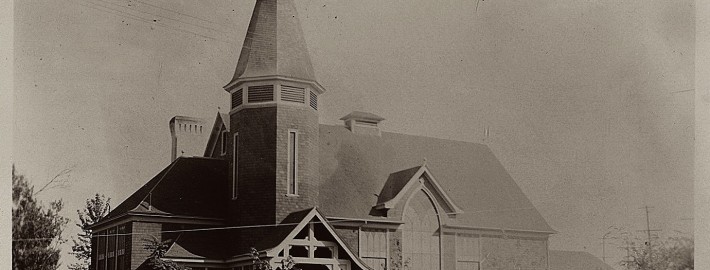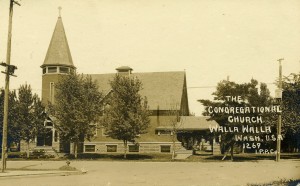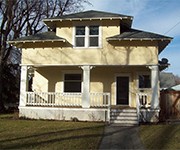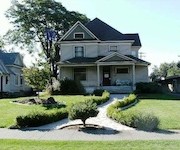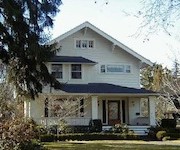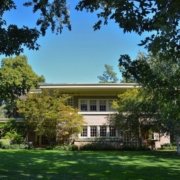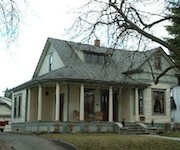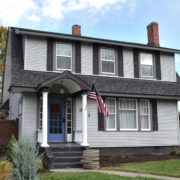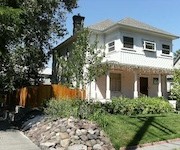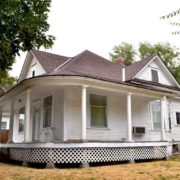First Congregational Church: The Forgotten Church
The History and Brief Life of the Third Building of First Congregational Church of Walla Walla, and Circumstances That Led to the Construction of the Current Building
Stephen Wilen, Co-Chair
First Congregational Church Sesquicentennial Committee
April 2014
{Editor’s Note: Please also see our page titled The Congregational Church: The Forgotten Dream}
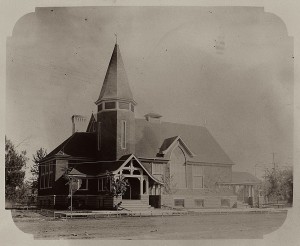
The third building of First Congregational Church shortly after completion. Note the wood framing for the sidewalk, still waiting to be poured. Photo courtesy of Whitman Archives.
After some 35 years on the southeast corner of 2nd and Rose Streets that included two different buildings and two fires, First Congregational Church moved into a noble new edifice on the northeast corner of Alder and Palouse Streets in 1900. Tenancy in this new building was short; it, too, was a victim of fire a mere 22 years later – the third the congregation had suffered in barely over half a century. Although its dedication represented a triumphant moment for the congregation and the city of Walla Walla, because of a rapid gathering in of new members over the first few years of the 20th century, in less than a decade it could be seen that this building would soon be woefully inadequate to serve the needs it was designed to meet. As early as 1909, church leaders were looking to build bigger. Thus, the fire in January 1922, which doubtless caused damage to the structure – albeit damage that probably could have been repaired – was instead viewed as a sign to forge ahead with a new, more suitable place of worship for the growing congregation. While it is possible that numerous historical artifacts pertaining to this third building may have perished in the fire, two other factors are critical to its fate of being largely forgotten: its relatively short life of 22 years; and the fact that before it was even ten years old it was viewed as obsolete.
* * *
The earliest mention of a new First Congregational Church building was in a Report to the Church dated November 1, 1894, in which the second of three points made by the Rev. Dr. Edward Lincoln Smith, in his acceptance to the call of minister to First Congregational Church, stated, “The enlargement of its plans including the purchase or erection of a residence for its minister and the erection of a new house of worship fully equipped for all the different lines of work which a modern church in a city of this size may have in mind.”
Trustees meeting minutes for November 25, 1895 record four sites being considered for a new church building. These included the then current site at 2nd and Rose; Palouse and Alder; 1st and Poplar; and opposite First Presbyterian Church. On January 1, 1896, Trustees minutes note that two more sites were being considered: 2nd and Birch; and the Anderson Estate on Alder (Prof. Louis A. [who was clerk of the Trustees 1895 – 96] and Mabel Baker Anderson). On January 27, 1896, the Trustees considered that most of these properties were very expensive to consider, with prices between $10,000 and $12,000. Only the site at 1st and Poplar, with an unfixed price in the $2,000 to $2,750 range, was within the budget.
On November 28, 1895 at a Business Meeting, it was determined that the current church site at 2nd and Rose was inadequate for the proposed new church, and that the members be asked to express their opinions between that site and the others being considered.
At the Business Meeting on May 7, 1896, the site at Palouse and Alder Streets was discussed. An offer of a building site there of 100×100 feet or 120×120 feet “if desired” would be donated; the name of the benefactor was not disclosed. It was decided to put this offer to a vote of the congregation and that vote would be binding. A first ballot on May 21st resulted in 44 votes for the Palouse and Alder site. A second ballot at a Special Meeting on May 25th tallied 58 votes for Palouse and Alder and 44 votes for the existing site at 2nd and Rose Streets. It was moved and accepted that the donor of the Palouse and Alder site be made aware of the outcome of the vote that the church “accept the property after examination of the deed and title.” Also, in a gesture of what could only be described as holy hubris, it was moved and carried “to accept the gift on the condition that the triangular piece of property opposite be also placed under control of the church.”
Two days later at a Business Meeting, Prof. Anderson noted “that the donor stood by the offer made in the spring, viz. that the lot on the north east corner of Palouse and Alder streets would be donated to the church for a church site, but that the requirements of a vote of the church previously made to the effect that the triangular piece of property on the N.W. corner of the same streets be placed under the control of the Trustees, could not be complied with.” He pledged that “said triangular piece would not be used in such a way to be detrimental to the church.”
At the Trustees meeting on September 7, 1896, it was voted to accept the gift of property on the northeast corner of Alder and Palouse Streets, “the title having been found to be perfect,” and on September 10th at a Special Meeting it was made known that “Mrs. L. F. Anderson was the intending donor.” (In all probability, she did not commingle her personal wealth with that of her professor husband’s. Regardless, one must wonder how Prof. Anderson maintained such an air of detachment while keeping Trustees and Business Meeting minutes during the several months that his wife was known solely as the “anonymous donor.”) It was decided that a letter would be written accepting her gift, but – and again with a slice of hubris – including a statement to the effect that “she is the actual owner of the triangular lot on the N.W. corner of Palouse and Alder sts…and her written guarantee that said triangular tract shall never be used in any way detrimental to the church…” The letter was to go on to express “deep appreciation of her noble and generous gift.”
This controversial bit of land was eventually given to the church, although their ownership was fairly brief. In July 1904, the Trustees voted, “…the triangular tract of land at the intersection of Palouse and Alder Sts recently acquired by deed from Mrs. and Mr. L. A. Anderson be devoted to the city of Walla Walla for use as a public park. The city is obligated to refrain from the erection of any building or edifice upon said tract of ground and to prevent the use of said tract for any purpose undesirable to the proper use of said house of worship…”
At the Business Meeting of October 29, 1896 the following was noted:
“Mr. H. A. Reynolds introduced the following in regard to the proposed new church edifice:
For the purpose of bringing before you the matter of a new Church Building suitable for our work, the following suggestions are offered:
That for the purpose of estimating our resources the present site and building be valued at $5000.
That a committee of three be appointed to make investigation and determine approximately the cost of a building such as we will probably need.
That the same committee then examine, as fully as possible, into the feasibility of securing annual subscriptions for raising the amount needed, in addition to the sums above mentioned, to complete the church; and report to the church at as early a date as possible.
That four years be set as the date towards which we will work for the beginning of the erection of the church building.
That it be our definite purpose to have a church, when completed, free from any interest bearing debt.
It is hoped that if Providence should provide the means, no plans will be adopted that will in any way impede the earlier completion of the work; also that if sufficient means be provided without the necessity of selling the present property, we may feel it wise to retain it for work covering somewhat the same ground that institutional churches do.”
At the Business Meeting on December 3, 1896, the Church Building Committee reported “nothing definite to report at present but that applications had been made in regard to some church plans.”
Bountiful finances and church treasuries throughout history have been an oxymoron of sorts. As early as December 28, 1896, when one might think the church would be intoxicated from anticipation over a new building, instead the Trustees minutes for December 28, 1896 record that the treasurer grumbled, “sidewalk expenditure on the new lot was $16.00, a little more than it had been estimated,” but that it had been paid.
At the Business Meeting on March 25, 1897, it was proposed “that the church adopt a general plan of erecting two buildings, one a church building proper, for worship only, and the other a Parish House, for the secular needs of the church.” It was further determined that the church request a building loan of $5,000 from the Congregational Church-Building Society (CBS), to be made interest-free, a seemingly impertinent demand.
On April 15, 1897, a letter was received from Mrs. L. J. Reynolds and Elizabeth H. (Mrs. D. S.) Baker offering a loan of $2,500, with seven stipulations regarding placing the property under their control by a Deed of Trust. The church received a reply from the Church- Building Society on April 29th that they would not loan more than one-third the value of completed improvements for a new building.
At a Trustees meeting on January 27, 1898, Rev. Smith asked whether $4,000 might be raised by fall in order to lay the foundation that winter and plan for building in spring 1899. Minutes from April 29, 1898 disclose that a committee, comprised of Mssrs. Penrose, Elliott, Reynolds, McLean, DeMent and Williams, was appointed to prepare plans for the new building. However, success eluded those campaigning for $4,000; minutes from September 19, 1898 note that the goal had to be downsized to $2,500. Be that as it may, a minor miracle seems to have been visited on the church, as the Trustees meeting minutes for October 25, 1898 report that $4,037.50 had been raised.
It was noted that on September 15, 1898, “The Church Building Plans committee presented written report through H. A. Reynolds: ‘That at a meeting held Aug 29th after thorough discussion the committee recommended to the church that the ground floor of the new church in contemplation should be about 60×80 feet, with main audience room about 60×60 (estimated seating capacity 400), and a room, opening into main room, about 20×60, and that there should be a basement for Sunday School rooms, kitchen, etc. It was the idea of the committee that the church should be so planned as to reasonably meet the present needs, but not to abandon the idea of a Parish House for the larger work of the church.’ This was adopted after amending ‘400’ to ‘400 or 500’.”
At the September 29th Monthly Meeting, it was voted to delete the words, “for worship only,” from the minutes of the March 25th meeting. Yet more chutzpah can be read in the last words of the following: “On motion it was voted that the Church Plans Committee be instructed to take no further action till they consult a competent architect…and to procure suggestions or rough drawings from the competent architect and submit them to the Church without incurring any expense.”
On October 27, 1898 at the Monthly Meeting, the Trustees recommended that formal application be made to the CBS for a loan of $3,000, and that “Trustees be authorized to mortgage said property to Congregational Church-Building Society.”
It was further recorded that, “The Clerk stated that Mr. Smith wishes to report from the Church Building Plans Committee that they had in obedience to the vote of the Church employed as a competent architect, Mr. John Arthur Rogers, of Chicago, Illinois and that as yet the Committee could report simply, ‘Progress’.”
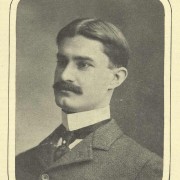
John Arthur Rogers ca. 1898. Photo courtesy of Ryerson and Burnham Architectural Libraries, Art Institute of Chicago.
But who was this John Arthur Rogers, and how did a small church in a still primarily agricultural community select an architect from Chicago? It seemed unlikely that a search would have taken church leaders to Seattle or Spokane, let alone Chicago, and that they would have relied on local resources for the design of the new church. At that time, Walla Walla had two primary practicing architects: George Babcock (1832 – 1907); and Henry Osterman (1862 – 1936). Babcock’s output was prolific during the 1880s, although his arguable masterpiece, Memorial Hall on the Whitman campus, dates to 1899, late in his career. Osterman, a generation younger, initially was seen as a more plausible candidate. Although not a member of First Congregational at the time, Henry and Genevra Osterman joined the church in 1902. Their three daughters, Henrietta, Elizabeth and Ruth, also became members beginning in 1906. Osterman became very active in the church, serving as a Trustee, and being elected Chairman of the Board in March 1912.
The fact remains, for reasons that may never be known for certain, neither local architect was chosen to design the third building. It is defensible speculation that the choice of Rogers, who was only 28 years old at the time, may be tied to First Congregational’s negotiations with the CBS to obtain a building loan. The CBS published a periodical, Church-Building Quarterly, in which architects occasionally placed advertisements. Mr. Rogers may have come to the attention of the Trustees via this publication, or the CBS might have recommended him. Proof of a loan to First Congregational Church of Walla Walla from the Church-Building Society was substantiated in a review of a number of their issues between January 1901 and February 1903. A loan of $3,000 was listed under disbursements in January 1901. In September 1901, a refund from the CBS of $200 was recorded. For the first few years of the 20th century, small payments every few months from First Congregational to the CBS were recorded in the Quarterly.
The Construction News magazine for October 19, 1898 reported the following concerning architect Rogers and the new Congregational Church for Walla Walla:
“Mr. Rogers is also at work upon plans for a $13,000 frame church, to be built in Walla Walla, Wash., for the Congregational society. Rev. Edw. L. Smith, pastor. It will be lighted by gas, steam heated and have pew seating for 500. SPECIFICATIONS INCLUDE – Hard Plaster, Yellow Pine, Pipe Organ, Cement, Cabinet Work, Oak Pews. CHAPEL – Val., $18,000”
And in its May 3, 1899 issue, it reported:
“Chicago, Ill. – John Arthur Rogers, Ashland block, is designing a brick church, 45×95, to be built for the Congregational Society in Walla Walla, Wash. It will have shingle roof, gas and electric fixtures and be heated by steam.”
At the Business Meeting on April 13, 1899, it was moved and carried that the church plans be adopted as a whole, and that they be sent “at once to architect Rogers for specifications.”
The Walla Walla Statesman on April 22, 1899 contained the following article, headlined Congregationalists Will Build:
“At a business meeting of the Congregational church last night definite arrangements were made for the erection of a $10,000 church building, at the corner of Alder and Palouse streets.
The new church building is to be 100×80. There will be a brick basement under the auditorium, in which will be a large Sunday school room and three large class rooms, a library, service room, pantry and kitchens. The main floor will be divided into a large auditorium with a seating capacity of 500 people, large parlors, pastor’s study and vestibule. The pulpit will be situated on one of the long sides of the auditorium and the pews form an arc of a circle facing it. A large organ loft will be constructed, in which it is hoped to place a pipe organ. The building will be of pressed brick, with the upper part of fancy shingles. Stained memorial glasses will be put in; some of them will probably be donated by the Sunday school classes. The building will be completed September 1.”
On May 23, 1899, the Trustees voted to pay property taxes of $4.30 on the new property.
It was decided on May 25th to add a sliding door between the parlor and auditorium “if within means.” The Plans Committee was instructed to compare the new plans against the preliminary ones to verify that all requested changes had been made. Further, that the “Building Committee be empowered to receive bids for the erection of a new church building,” and that the “Trustees be empowered to enter into a contract or contracts for the construction of the building.”
Minutes from October 28, 1899 note that, “Building Committee instructed to complete basement of new church so as to make it comfortable for use.”
The completed edifice was, like many buildings of the time, an architectural hybrid, but its appearance places it primarily within the Shingle Style. The basement facing, extending upward through the top of the basement windows, appears to have been of rusticated sandstone blocks. The walls above that were faced with simple shingles. The main entrance was located to the left of center and elevated five steps above the sidewalk. This entrance was protected by a covered porch, which imparts an impression of English Arts & Crafts to the façade. Its gable roof featured an upward sweep on the elongated right side that provided cover to an adjacent basement entrance. Gothic pointed arches were incorporated into side trusses supporting the gable roof, and a stylized Celtic cross was designed into the trusses immediately below the peak of the roof. At the far right of the Palouse façade was a porte-cochère; it must be remembered that very few residents owned cars at the time the building opened. A Norman tower, fairly squat with limited upward thrust of approximately 80 feet, was also clad in shingles, and rose directly above the main entrance. Its low, octagonal spire was topped with a Celtic cross. Near the center of the Palouse façade, the main roof gable was penetrated by a small gable, into which a large pointed arch window was placed. On either side of this large window were smaller rectangular windows with pointed arch tracery. A large paneled chimney could be seen rising from the rear slope of the main gable, and a vent from the peak of the gable.
It may be a bit of a stretch, but similarities can be seen in the distribution of the components of the façades of both First Congregational Church and Kirtland K. Cutter’s marvelous design for St. Paul’s Episcopal Church, built the same year. Cutter’s design falls more within the Arts & Crafts movement. With its low, thick tower plus the fact that it “hugs” the ground, it projects a strong linear flow, while First Congregational, despite a taller spire, with its elevated main floor, displayed neither strong linear nor vertical thrust.
January 2, 1900 was a grand evening in Walla Walla. The Walla Walla Statesman on January 6th, in an article entitled Dedication of Congregational Church, reported:
“Every denomination turned out in force on Tuesday night to attend the dedication services of the handsome new Congregational church at the corner of Alder and Palouse streets, the history of which was published exclusively in the Statesman. To say that the edifice was crowded with a pleased congregation will but faintly express the satisfaction of everyone present. It is a church both inside and out that would be a credit to any city in the land. The gas lamps in a magnificent chandelier lighted everything up beautifully. The acoustic properties are excellent and gave great satisfaction. The dedicatory service was delivered by the Rev. E. L. Smith.”
W. D. Lyman’s History of Old Walla Walla County contains a lengthy history of First Congregational Church. (Prof. Lyman was a Trustee of First Congregational Church.) Pertaining to the new third building, he wrote:
“…It is only necessary to add that the hopes above expressed have been quite fully realized in the subsequent work of the church. Rev. E. L. Smith continued to minister unto the society until November, 1898, when he was succeeded by Rev. Austin Rice, the present pastor. In 1899 an elegant new church edifice was erected on the corner of Palouse and Alder streets, and the same has been occupied as a place of worship since January, 1900. The present structure, by reason of its convenient and commodious basement, is peculiarly well fitted for building up the social life of the church. The Sunday-school, under the supervision of President S. B. L. Penrose, has become one of the strongest in the town, having an average attendance of about one hundred and fifty. The present total membership of the church is two hundred and twenty-three.”
At a meeting of the Trustees on January 23, 1900, the treasurer was authorized to pay for the moving of the organ. A meeting held after church on January 28, 1900 was for the purpose of discussing renting the old church building to the Lutherans, and a committee was appointed to make a determination in the matter.
By September 25, 1900, the scarcity of money had again reared its ugly head; the church owed $63 in delinquent property taxes. A church dinner was planned, and it was recommended that all members be asked – strong-armed might be more appropriate – to attend and contribute monies so the church could make a $3,000 payment owing (most likely this referred to the loan from the CBS).
The 1900 Annual Report of the church listed the following expenses for the new building:
Architect fee: $225.00
Contractor: Cox & Bailey $6,932.25
Pews: $874.00
Electrical: $235.85
Plumbing: $229.05
City taxes: $37.50
Pastor’s salary: $1,200.00
The expectations of the new building were short-lived. On February 1, 1885, church membership was just 133. Due to an influx of new parishioners in the last years of the 19th century, and particularly during the first few years of the 20th*, in its October 1, 1908 issue, The Pacific magazine from Berkeley and San Francisco noted, “The First Congregational Church of Walla Walla has decided now to remodel its present building at a cost of $20,000. Dr. Brooks will leave Oakland for Walla Walla the last of October.”
*The Congregational Year-Book for 1899 listed 195 total members, including 29 new members for that year, six adult baptisms and seven infant baptisms. In the 1900 volume, 206 total members were listed, including 17 new members, six adult baptisms and one infant baptism. The value of the church building in the 1900 Congregational Year-Book was $12,000. Indebtedness of $3,000 to the Church-Building Society was recorded.At the 52nd annual meeting of the Congregational Church-Building Society in January 1905, the following was recorded:
“An invitation from Whitman College and the First Congregational Church of Walla Walla, Wash., to the Congregational Church-Building Society to hold its meeting this year at Walla Walla in conjunction with the other home societies was presented. It was voted that the thanks of the Society be sent to Whitman College and the First Congregational Church of Walla Walla for this cordial invitation, but in view of the many questions involved in planning a meeting at that point, which are now being considered by the committees of the home societies in conference with each other, that this matter be referred to the Board of Trustees.”
The 1910 Annual Report, however, contains a report dated January 31, 1910 that stated, “In November, 1908, Rev. Raymond C. Brooks, from Oakland, California succeeded to the pastorate and was installed in 1909, and, including the present date, 99 members have been received by him, and it has been formally voted to erect and dedicate by September, 1912, a new church building on the present site to cost at least $50,000.” With a congregation that numbered 429 members on August 1, 1910 and a building with a seating capacity of 500, it can be seen why as early as 1909 there was already talk of the need for a new building.
Minutes of the Trustees meeting of May 4, 1909 note that of $1,900 pledged to the building fund, $103 had been paid thus far. Trustees also voted to have Henry Osterman check into placing an electric light at the south entrance (porte-cochère) to “remedy a dangerous condition.”
At the May 27, 1909 meeting of the Trustees, it was noted that the Elks had backed away from an offer to purchase the lot at 2nd and Rose, and it was decided to option the property to Leonard & Lathrop until June 15th with a listing price of $10,000.
That date having passed, the Trustees decided on June 18th to investigate the 2nd and Rose site as a possible location for the new church building; however, the following day Leonard & Lathrop closed a deal and the property was sold.
Saddled with their current structure for at least the time being, and commensurate with the above-cited article in The Pacific magazine, minutes from the Trustees meeting on July 6, 1909 state, “Mr. Osterman presented the plans, specifications, and contract for the building of the addition to the church in accordance with the previous vote of the church. The contract calls for an outlay of $1,075.”
Although none of the photographs and postcards of the third building show it with an addition, it appears that the addition was indeed built. On October 6, 1909, the Trustees “voted that the thanks of the Board be extended to Mrs. Baker for her generosity in providing for the remodeling of the church kitchen, and to Mrs. Anderson for her interest in overseeing this and other improvements in the basement.” More apropos to the accomplishment of this addition: on February 22, 1910, the Board voted thanks to Henry Osterman and Edward Ruby, the former for his 1909 plans for the addition, and the latter for supervising its construction. It was further voted that Mssrs. Osterman and Ruby be credited with contributions to the new building fund at the going market rate for an architect’s and construction supervisor’s fees.
With nary a sou in the building fund, but with that previously-seen hubris, presumably this time over their rapidly-growing congregation, the Trustees announced on December 22, 1910 that the Seattle architectural firm of Beezer Brothers had been selected as architects of the new building. Beezer Brothers was prominent in Seattle between 1907 and 1923. While much of their work is comprised of commissions from the Roman Catholic Church, their œuvre also included commercial business blocks and notable residences. It must be assumed that their choice for the new Congregational church, however, was not based on their body of work in Seattle, but rather on the fact that they were the architects for the Baker-Boyer National Bank Building in 1910. If this was a “keeping up with the Bakers” game, it must be noted that it was the Bakers/Andersons who were probably keeping up the Congregational church! (In 1921, Levi Ankeny commissioned Beezer Brothers to design his new First National Bank Building [now Banner Bank] at 2nd and Alder; this is generally considered the firm’s finest bank design.)
The February 12, 1912 minutes of the Trustees meeting specified the following:
“1. Beezer Brothers of Seattle are to be architects for proposed new church building. They are to associate with themselves in this work Henry Osterman of Walla Walla.
2. Plans furnished are to include the entire improvement of present plant and are to be drawn so that sum of bids accepted or expense undertaken for finished and furnished buildings is not more than $70,000. Final plans are to meet the approval of First Congregational Church and no extra charge is to be made for preliminary or other work so not approved.
3. The architects’ fee is to be six percent of total cost and is to include all preliminary and final drawings, architects’ supervision of construction, and travelling expenses. If the First Congregational Church chooses to have work done without a general contractor, thus necessitating constant supervision of business details of construction, the fee is to be ten percent of the total cost.
4. Beezer Brothers will expect a partial payment at about the time construction begins.”
Henry Osterman was elected Chairman of the Board at the Trustees meeting in March 1912. It is well known that following a sermon by Dr. Raymond C. Brooks on May 6, 1912, First Congregational Church voted to turn over in excess of $60,000 from the building fund to Whitman College to prevent it from going under. Despite the depletion of funds to build, involvement with the Beezer Brothers continued for two more years. At the April 21, 1914 Trustees meeting, it was noted that Beezer Brothers “had met the conditions with reference to plans for the new church and should now be paid $2,000.” However, the church did not have the funds to meet this obligation, and on May 19, 1914, it was decided to see if it could be raised by subscription or any other means feasible. (No extant plans for this building could be found among Beezer Brothers archived material in the University of Washington Library Special Collections.)
Precisely how the contract between Beezer Brothers and First Congregational Church was resolved is not known, but the building that eventually was built was not from the Beezer Brothers’ drafting table.
Returning to more mundane matters, with winter approaching, Henry Osterman was authorized by the Trustees on October 20, 1914 to either procure a new furnace or repair the existing one; he opted for the latter. (Pray that this decision did not lead to the fire of 1922, and that the good Mr. Osterman is not paying the price in the “eternal furnace.”)
Nothing further could be located regarding a new building between 1914 and 1922. On January 8, 1922, the evening service had just begun when smoke from a basement fire forced everyone to vacate the building. As firemen fought the blaze in the cold night air, ladies from Central Christian Church across Palouse Street provided firemen and parishioners with coffee and sandwiches. The amount of damage caused by the fire itself is not documented, but smoke damage was extensive, and the pipe organ was evidently seriously damaged. At a meeting on Monday morning, the Trustees voted to demolish and rebuild.
Plans were finalized by Osterman & Siebert, with whom Osterman was in partnership at the time, on May 30, 1922 for the Parish House (extant) and an imposing church in the “New England meeting house” style, similar to what eight years later was built, but with more florid ornamentation. The interior in particular abandoned the traditional Congregational meeting house concept entirely, with its three-sided balcony approached via twin grand staircases on either side of the chancel, and a resplendent pipe organ case that filled the entire back wall of the chancel. While the church structure was not realized, Osterman & Siebert’s more restrained plans for the Parish House were, and that structure, which continues to serve the church and the community, was dedicated December 9, 1923.
Henry Osterman retired in 1927 and moved to Seattle, where his son, Hugo, had an architectural practice. He died there in 1936. The Beezers died in 1929 and 1933 respectively without seeing their plans for First Congregational Church in Walla Walla come to fruition. It fell to Arnott Woodroofe (1879 – 1976), an Englishman and member of the Royal Institute of British Architects, to provide plans for the church that was actually built. A contract for the church building was granted to O. D. Keen Construction Company in May 1929. Construction certainly would have been underway at the time of the financial collapse in October 1929, and Woodroofe’s plans depict a scaled-down – and thus fortuitous by meeting house standards – version of Osterman & Siebert’s 1922 submission. The Great Depression may have prolonged actual completion, as the church was not dedicated until February 1, 1931. After more than eight decades, this building with its dramatic copper-clad stiletto spire, is still one of Walla Walla’s tallest structures. Unhindered by any view-obstructing buildings on the small triangle across from it, First Congregational Church continues to dominate the vista east up Alder Street.
* * *
References:
- W. D. Lyman, An Illustrated History of Old Walla Walla County, Vol. 1, 1918
- First Congregational Church Trustees Minutes, 1895 – 1901 and 1909 – 1915
- Records of the First Congregational Church of Walla Walla, Washington Territory, complied by Rev. P. B. Chamberlain and Edward Eels, June 1866, and including minutes of various committee meetings through February 1, 1900
- Whitman Archives, Penrose Library, including 41 boxes of archived First Congregational Church material
- Washington State Department of Archeology and Historic Preservation, Michael Houser, State Architectural Historian
- Walla Walla Public Library
- Kammy Hill, Walla Walla City Clerk
- University of Washington: Special Collections and Built Environment Library
- Walla Walla Statesman, various dates
- Robert A. Bennett: Walla Walla: Portrait of a Western Town, 1804 – 1899, 1980
- Robert A. Bennett: Walla Walla: A Town Built to Be a City, 1900 – 1929, 1982
- City of Walla Walla Directories
- Jeffrey Karl Ochsner, editor, Shaping Seattle Architecture: A Historical Guide to the Architects, University of Washington Press, 1994
- HistoryLink.org
- Joe Drazan, Bygone Walla Walla on-line photos
- Bulletin of the Massachusetts Institute of Technology, Boston: Register of Former Students With An Account of the Alumni Association, May 1915
- Handbook of Architects and Builders, Chicago, 1908
- The Pacific, Berkeley and San Francisco, October 1, 1908
- Church-Building Society Quarterly, various dates
- Congregational Year-Book, 1899 and 1900
- Christopher Harter, Director of Library and Reference Services, Amistad Research Center, Tulane University, New Orleans
- Autumn L. Mather, Reference Librarian, Ryerson and Burnham Architecture Libraries, Art Institute of Chicago
- The Construction News, October 19, 1898; March 30, 1907
* * *
Addendum
John Arthur Rogers and Ernest Woodyatt
John Arthur Rogers was born in Louisville, KY in 1870. He graduated from Northwestern University in 1892, and the Massachusetts Institute of Technology in 1894, with an advanced degree in Architecture. In 1898, Rogers was briefly in partnership with his brother, James Gamble Rogers. He was also for a short while associated with the Chicago architectural firm of William LeBaron Jenney, architect of the Home Insurance Building, considered America’s first skyscraper. Additionally, he worked for a short time for the noted Chicago architectural firm of Holabird & Roche. He was a partner in the firm of Phillips, Rogers & Woodyatt from 1898 to 1905, with offices at 1615 Ashland Block, Chicago, during which time he was also retained as designer and superintendent of construction for the Chicago Board of Education.
No information could be located on the partner Phillips, and neither Phillips’ nor Woodyatt’s names appear in connection with the design for First Congregational Church. Phillips’ name disappeared from the partnership in 1905, when the firm became known as Rogers & Woodyatt. John Arthur Rogers worked on several of the early steel construction buildings in Chicago, and built an annex to the Ashland Block in that city. They also designed a number of homes in the Lakeshore District of Evanston, Illinois that are on a local registry of historic properties in that city. Rogers & Woodyatt practiced in Chicago until 1916, and both men were active members of the Chicago Architectural Club.
Due to health reasons, Rogers moved to Daytona Beach, FL around 1917, where he remained in practice until his death in 1934.
Roger’s brother, James Gamble Rogers, was a prolific architect who overshadowed his brother, He was a Yale graduate who studied at the École des Beaux- Arts in Paris. In Chicago, he also worked in the office of William LeBaron Jenney, and worked for Burnham & Root before going into practice with brother John Arthur Rogers in 1898 for a brief time. James Gamble’s many commissions can be seen on the campuses of Yale, Northwestern and Columbia Universities. He was also architect for the ten-story Church House of 5th Avenue Presbyterian Church in New York, among numerous other notable commissions.
Ernest Woodyatt (1875 – 1922) was also a graduate of MIT, and in 1894 was employed by the renowned Chicago architectural firm of Burnham & Root. Daniel Burnham was Woodyatt’s uncle, his mother being Burnham’s sister, and Woodyatt grew up across the street from the Burnhams in Evanston. Along with Adler & Sullivan, Burnham & Root were pre-eminent in the emergence of the Chicago School of architecture and the early development of the steel-supported multi-story building. Burnham was also chief architect for the World Columbian Exposition in Chicago in 1893. Woodyatt, too, was an active member of the Chicago Architectural Club and was an officer of the club in 1905.
Henry Osterman and Victor Siebert
Henry Osterman was born near Essen, Germany in 1862. It is not known why he and his three brothers emigrated to the U.S. in 1899 and settled in Walla Walla. None could speak much English, and his three brothers did not remain for long in Walla Walla, returning to Germany. Working first as a contractor, Osterman is thought to be largely self-taught as an architect. He received an architectural license from the state in 1919 and hung out his shingle as an architect. During his extensive career in Walla Walla, he designed many notable buildings, including City Hall, Walla Walla County Court House, Carnegie Library, Central Christian Church, Walla Walla High School and Gymnasium, Green Park School, Sharpstein School, the YMCA, his own home at 508 Lincoln Street, the Dixie School and of course the First Congregational Church Parish House. He and his wife, Genevra, joined First Congregational Church in 1902, as did his three daughters later. There is no mention of his son, Hugo, who later became an architect in Seattle, joining the church.
Osterman took on as partner Victor E. Siebert in 1912. Siebert was a native Walla Wallan, born in 1884. He was a member of the First Church of Christ, Scientist. Sometime after the dissolution of the partnership, Siebert moved to Long Beach, CA.
An Amusing Anecdote
On January 23, 1900 one A. Hauerbach was hired as the church janitor for the new building, but he was required by the Trustees to hire an assistant for Sunday services, which would enable him to sing in the church choir. A Mr. Palmer was hired to assist Mr. Hauerbach on Sundays. It was written that “both are not to be absent from duty at the same time without very good reason.” This undoubtedly reflected on displeasure in March 1899 when the then-janitor failed to ring the bell on time. Salary was set at $14 per month, to be split two ways.
On January 28th, it was noted that, “Mr. Hauerbach had refused to accept the janitorship of the new building under conditions imposed and Mr. Chas. Palmer had therefore taken the work under practically the same conditions.”
Trustees meeting minutes from December 17, 1898 noted that one Prof. Hauerbach was the Musical Director of the church at $10 per month, and by mid-1899 he no longer held that position. (The salary that year for Miss Chamberlain, the organist, was a mere $5 per month.) Trying to determine if the Musical Director of 1898 and the short-lived janitor of 1900 were the same person, City Directories were checked. At the time, there was only one Hauerbach – Otto A. Hauerbach, Professor, Whitman College, residence Billings Hall. While it is not conclusive proof, the fact that the church briefly employed a singing janitor might lead to speculation that he and the former Musical Director were one and the same person.
Beezer Brothers
The Beezers were not only brothers, but also twins. Louis (1869 – 1929) and Michael (1869 – 1933) were Pennsylvanians. They began their partnership in 1892, designing numerous works in their home state before moving to Seattle in 1907, where they remained active until 1923, when Louis left to open a branch in San Francisco. Their works, while mainly in Seattle, span the west coast from California to Alaska. The most commissions they had outside of Seattle, however, were in Walla Walla. Devout Roman Catholics, they designed numerous churches, schools and rectories for the Roman Catholic Church, and supervised the construction of the old St. Mary’s Hospital in Walla Walla.
Arnott Woodroofe
Born in England in 1879, Arnott Woodroofe moved first to Canada, and arrived in the United States in 1898. Little is known of his architectural training, but he was a member of the Royal Institute of British Architects. He set up a practice in Tacoma, where his designs reflected the Arts & Crafts movement. Eventually he relocated to Spokane, where he continued to practice into the 1950s. He left Spokane and moved to Walla Walla for two brief years, 1929 – 1930, his only known building here being the current First Congregational Church. He returned to Spokane from Walla Walla and died there in 1976, aged 97.
Ephemera Relative to Nothing in Particular
Three separate payments made to the Kimball Organ Company in 1931 for the pipe organ still in use included:
$520.00
$2,000.00
$2,680.00
$5,200.00 total
The Great Depression notwithstanding, an additional $2.15 was allocated for the purchase of a reading lamp for the organ.

